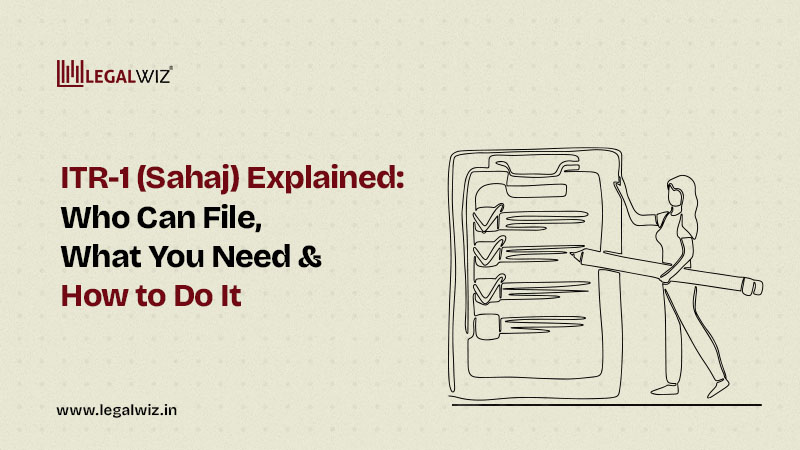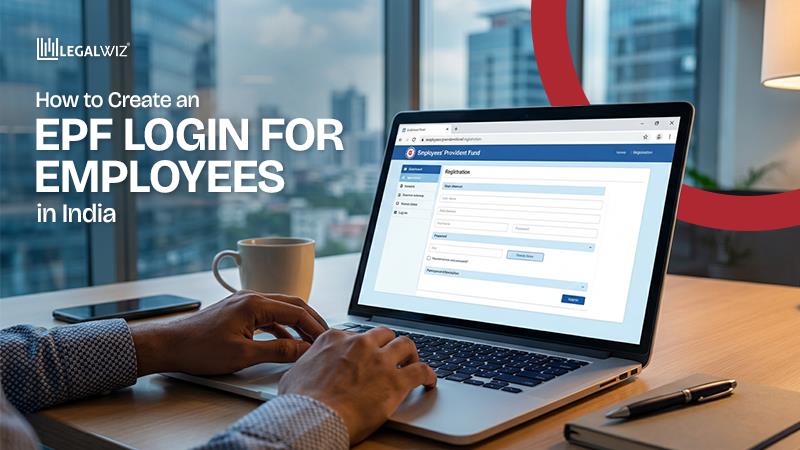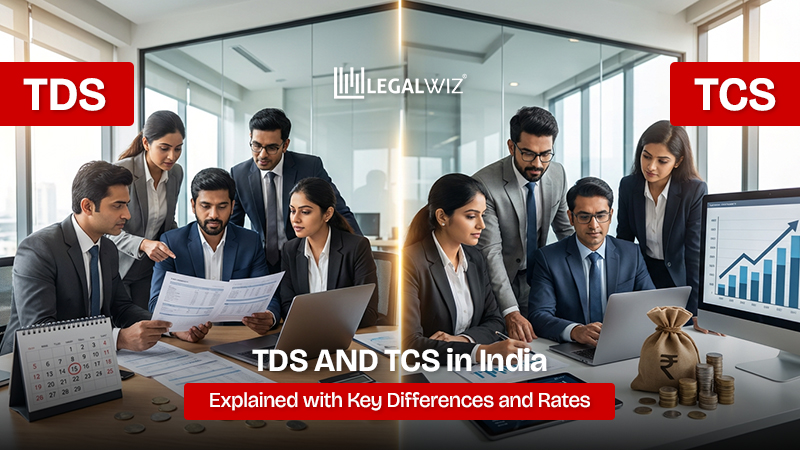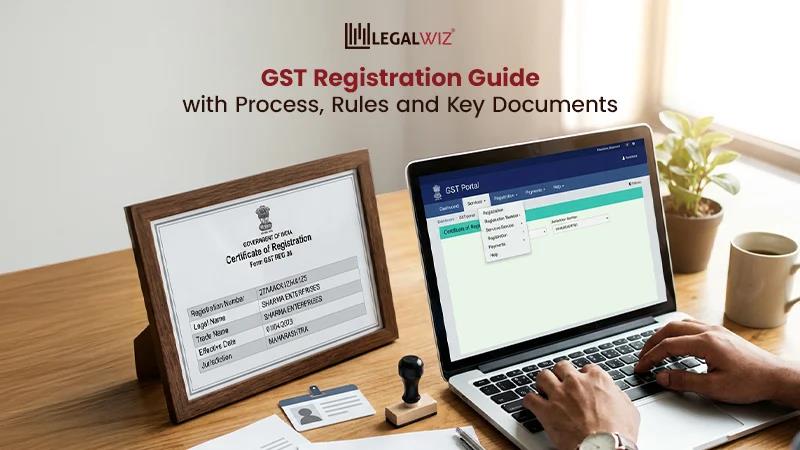ITR-1 (Sahaj) Explained: Who Can File, What You Need & How to Do It
Meet ITR-1 – The Chai and Biscuit of Tax Returns
Think of ITR-1 as that comforting cup of chai with a biscuit on the side—simple, fuss-free, and perfect for everyday taxpayers. Officially known as Sahaj, which literally means “easy,” this is the go-to income tax return filing form for individuals with uncomplicated incomes.
No complicated capital gains, no messy business income, just a straightforward form made for salaried individuals, pensioners, and those earning a little extra from interest or a single house property.
But before you pour that chai and settle in, remember, ITR-1 isn’t the only tax form on the menu. Choosing the wrong one is like ordering spicy biryani when all you wanted was buttered toast, a guaranteed regret. That’s why we’ve put together an ITR-1 to ITR-7 forms guide for you to explore, so you can confidently file with “the one” meant for you.
It’s the tax world’s version of a smooth autorickshaw ride—quick, affordable, and gets you where you need to go without unnecessary drama. Now that you’ve met ITR-1, let’s pull up a chair and see who’s invited to this tax party, what the form looks like, and what you’ll need to file it without a last-minute scramble.
What is ITR 1 (Sahaj)? The ‘Beginner-Friendly Mode’ of Tax Returns
If taxes had a “simple, no-headache mode,” ITR-1 (Sahaj) would be it. This form is tailor-made for resident individuals with uncomplicated incomes, think salary, pension, one house property, or interest earnings, and a total annual income of up to ₹50 lakh.
Basically, if your tax life is plain vanilla, this is your ride. No complicated capital gains drama, no crypto chaos, no offshore property sagas, just a clean, straightforward tax return form.
Key Features That Make ITR-1 a Fan-Favourite:
- Easy to File: A simplified, single-page form ideal for salaried taxpayers who like quick solutions.
- Covers Basic Income Sources: Salary, one house property, and small “other income” like bank interest or family pension.
- Online Convenience: File directly on the Income Tax e-Filing portal with auto-filled details from your Form 16, AIS, and Form 26AS.
- Error Alerts: The system gives a friendly nudge if data doesn’t match, saving you from the dreaded taxman’s love letter later.
What’s New for AY 2025–26?
- Section 87A Rebate: Pay zero tax on income up to ₹7 lakh under the new tax regime.
- Standard Deduction: A neat ₹50,000 cut on salary income continues to keep taxable income lower.
- Better Pre-Filled Data: Your salary, TDS, and interest details flow in more accurately, making filing faster and less stressful.
If you’re curious about all the new tweaks and twists this ITR season brings, see what’s new in Income Tax Rules for AY 2025–26 and avoid missing deductions or facing surprises while filing.
ITR-1 is familiar, comforting, and stress-free. It won’t mix up a fancy tax cocktail, but for a simple, no-drama tax life, it’s perfect.
Who Can File ITR-1? The VIP Guest List for This Tax Party
Not every taxpayer needs to wrestle with long, complicated forms. ITR-1 (Sahaj) is designed for those with simple, straightforward incomes. Think of it as the fast-track entry to the tax world.
You can file ITR 1 if:
- Resident Individual: You must be an Indian resident for tax purposes. Non-residents and RNORs don’t get this invite.
- Total Income up to ₹50 Lakh: If your annual income doesn’t cross this mark, you’re good to go. Cross it, and you’ll need to upgrade to another form (like ITR-2 or ITR-3).
- Income Sources:
- Salary or Pension: Regular job income or retirement payouts.
One House Property: Earnings from a single-owned property (excluding cases with a loss from bringing forward previous years).
- Other Sources: Interest from bank deposits, family pension, or other small earnings that aren’t lottery winnings or speculative gains.
- Salary or Pension: Regular job income or retirement payouts.
- Clubbing of Income: If you’re adding your spouse’s or minor child’s income to yours (as long as it qualifies under the same rules), ITR-1 allows you to report it together.
Our take: If your tax life is plain vanilla, no foreign accounts, no share-trading thrillers, no crypto roller coasters, ITR-1 is the chilled-out buddy you want for tax season.
Who Cannot File ITR-1? (No Entry Zone)
While ITR-1 rolls out a warm welcome for simple taxpayers, it has a strict bouncer at the door. If your finances are even slightly complicated, this form won’t let you in.
Here’s who gets turned away:
You’re not eligible to file ITR 1 if you have:
- Capital Gains: Sold shares, mutual funds, property, or crypto and made a profit? Even one transaction kicks you out of ITR-1 territory.
- Example: Sold your old flat or booked profits from stocks last year? Say hello to ITR-2 instead.
- Business or Professional Income: Freelancers, consultants, shop owners, or anyone running a side hustle—this form isn’t for you.
- Think of it this way: ITR-1 can handle a 9-to-5 salary, not your late-night entrepreneurial grind.
- More than One House Property: If you’ve got a second home, whether rented out or vacant, you’re no longer eligible.
- Foreign Income or Assets: Earnings abroad, overseas bank accounts, or property outside India? ITR-1 can’t handle the international drama.
- Company Directorship or Unlisted Shares: Being a company director or holding unlisted equity shares means you’ll need a more detailed form.
- Agricultural Income Above ₹5,000: Small amounts are fine, but big farm income needs a bigger form.
- Cryptocurrency or NFT Transactions: Even a single crypto trade takes you out of ITR-1 eligibility because it’s treated like speculative income.
Think of ITR-1 as a no-frills flight—perfect for a carry-on bag (salary, interest, one house). Bring in excess baggage like crypto, capital gains, or foreign earnings, and you’ll need to upgrade to a bigger aircraft (ITR-2, ITR-3, or ITR-4).
What is the ITR-1 Format? (Breaking Down the Sahaj Blueprint)
Filing taxes can feel like entering a maze, but the ITR-1 form is more of a straight hallway with seven clear signboards. Each part asks for specific details, and once you know what goes where, it’s smooth sailing.
Let’s take a quick tour of the 7 stops on this Sahaj journey:
Personal Information
Your name, PAN, Aadhaar, address, contact details, and filing status.
Think of this as the “Hi, my name is…” section of the tax party, you’re introducing yourself to the Income Tax Department.
Gross Total Income Details
Here, you declare all your earnings from:
- Salary or pension.
- One house property (self-occupied or rented).
- Other sources, like interest income or family pension.
Tip: Double-check your Form 16 and bank statements to avoid under-reporting income.
Deductions & Taxable Income
All those tax-saving investments and expenses you’ve made under Sections 80C to 80U go here.
This is where you proudly showcase your ELSS, PPF, LIC premiums, or that health insurance policy you bought just to save tax.
Computation of Tax
Based on your declared income and deductions, your tax liability is calculated.
The system does the math; you just need to enter the details correctly, no PhD in numbers required.
Advance Tax & Self-Assessment Tax Payments
If you’ve already paid advance tax or made self-assessment payments, list them here to avoid paying twice.
Basically, this is your “Hey, I’ve already paid some of my dues” section.
TDS from Salary
Details of tax deducted at source by your employer, as reflected in Form 16.
Think of it as your employer saying, “We already sent some money to the taxman for you.”
TDS from Other Income
If banks or other institutions have deducted tax on your fixed deposit interest or other income, you enter it here.
Key Note: Every figure you enter must match your Form 16, AIS, and Form 26AS. Even small mismatches can lead to unnecessary notices from the tax department. Trust us, nobody wants that drama.
Documents Required to File ITR-1 (Your Tax Filing Survival Kit)
Even though you’re not required to physically submit these documents, having them handy makes filing ITR-1 faster, smoother, and error-free. Think of these as your “tax weapons” for battle day.”
| Document | Why You Need It | Pro Tip |
| Annual Information Statement (AIS) | Shows all your reported incomes, TDS, and high-value transactions for the year. | Always cross-check AIS with your own records to avoid missed entries or mismatches. |
| Form 16 (from all employers) | Contains salary details, allowances, deductions, and TDS deducted by your employer(s). | If you’ve switched jobs, collect Form 16 from each employer to avoid under-reporting. |
| House Rent Receipts (if applicable) | Proof for claiming HRA (House Rent Allowance) exemption under Section 10(13A). | Get the landlord’s PAN if rent paid > ₹1 lakh per year—this is mandatory for HRA claims. |
| Investment Premium Payment Receipts | For deductions under Sections 80C, 80D, etc. (e.g., LIC, PPF, health insurance). | Keep digital copies scanned; you might need them if the IT department asks for proof. |
| Form 26AS (optional but recommended) | A tax passbook showing all TDS and advance taxes paid on your behalf. | Cross-check with AIS and Form 16 to ensure no missing tax credits before filing. |
You don’t have to send these to the taxman, but keeping them ready saves you from the classic midnight panic search, you know, that frantic dive into old email folders two hours before the deadline.
| Want the full checklist with explanations of why each document matters and how it speeds up your filing? Check the full list of documents required for Income Tax Return filing to stay prepared and avoid last-minute panic or filing errors. |
How to File Sahaj Form? (Two Roads, One Destination)
Filing your ITR-1 (Sahaj) is no longer the mountain climb it used to be. The Income Tax portal gives you two clear routes to get the job done, and both lead straight to a taxman-approved finish line.
Mode 1 – Downloadable Utility (Offline Filing)
If you like having everything on your system and double-checking numbers before hitting upload, this route’s for you.
- Download the Excel-based Sahaj utility from the Income Tax portal.
- Fill in your income, deductions, and tax details offline, at your own pace.
- Generate the .json file and upload it back to the portal for submission.
Pro tip: Always download the latest version of the utility to avoid errors or compatibility issues while uploading.
(Need help? Here’s a quick guide on how to download the JSON utility for ITRso you don’t end up with the wrong file.)
Mode 2 – Online Filing (The Faster, Smarter Way)
For those who prefer a click-and-go experience, online filing is your best friend.
- Log in to the Income Tax e-filing portal.
- Choose ITR-1 (Sahaj) and start filling in details directly online.
- Review, submit, and e-verify—no extra uploads or file conversions needed.
Pro tip: The portal often auto-fetches details from your Form 16, AIS, and 26AS, reducing the chances of mistakes.
Whether you’re an old-school spreadsheet warrior or a modern-day portal pro, both roads lead to one thing: tax filing done right and on time. (And if you want the full scenic route, check out our detailed guide on How to file ITR 1 online for step-by-step instructions.)
Why File ITR-1 Even If You Don’t Have to? (Future You Will Thank You)
Just because your income is below the taxable limit doesn’t mean you should skip filing your return. Think of ITR filing as financial hygiene, not always mandatory, but skipping it can cause headaches later.
Here’s why hitting that “File” button is always a smart move:
1. Proof of Income – Your Financial Resume
An ITR acts like an official stamp saying, “Yes, I earned this much legally.” It’s often required by banks, landlords, or even employers as proof of steady income.
Mini tip: Especially handy if you’re a freelancer or have multiple income sources.
2. Smooth Loan & Visa Approvals – No Extra Drama
Planning to take a home loan, car loan, or even travel abroad? Many lenders and visa authorities ask for your past 2–3 years’ ITRs before approving applications.
Real-life example: That dream trip to Europe might get stuck because you didn’t have an ITR to show as proof of financial stability.
3. Easier Refunds & Tax Adjustments
Even if you’re not liable to pay tax, TDS may have been deducted by your bank or employer. Filing an ITR ensures you can claim that refund quickly without chasing the tax department later.
4. Protection from Future Notices or Penalties
Skipping ITR might not hurt today, but if you have financial growth later, past gaps in filing can trigger unwanted scrutiny from the tax department.
Think of it as a safety net for future-you—better to have clean records now than regret it later.
Filing an ITR is like flossing; you can skip it, sure. But when trouble pops up later (like a rejected loan or delayed refund), you’ll wish you had taken those five extra minutes.
Final Thoughts – Making ITR-1 Filing Truly ‘Sahaj’
At the end of the day, ITR-1 is built for simplicity, a no-drama tax return form for taxpayers with straightforward incomes. All you really need is:
- The right eligibility
- The right documents
- A few minutes of your time
And you’re done, probably before you know it.
But here’s the thing: simple mistakes can still cost you—wrong figures, mismatched TDS, or missing information can lead to tax notices you don’t want in your inbox.
That’s where LegalWiz steps in; we keep tax filing actually stress-free, handling the nitty-gritty while you focus on things you love (like enjoying your life in peace).
Filing ITR doesn’t have to feel like decoding a mystery novel. With ITR-1, the right prep, and a little help from the pros, tax season becomes just another day you checked off your to-do list, with time left over for dessert.
Frequently Asked Questions
Who is eligible to file ITR-1 (Sahaj)?
ITR-1 is for resident individuals earning up to ₹50 lakh from salary, one house property, or interest. If your tax life is plain vanilla, this form’s for you.
Can freelancers or business owners use ITR-1?
Nope! ITR-1 isn’t built for side hustlers, business income, or professional earnings. You’ll need ITR-3 or ITR-4—basically, a bigger tax backpack for your extra baggage.
Is it mandatory to file ITR-1 if my income is below the taxable limit?
Not mandatory, but smart. Filing builds your income history, helps with loans, visas, and refunds later. It’s like keeping a financial first-aid kit; you’re glad it’s there.
What documents do I need before filing ITR-1?
Keep your Form 16, AIS, house rent receipts, and investment proofs handy. You don’t submit them, but they save you from the classic last-minute “where-did-I-put-that-paper” panic.
Can I file ITR-1 if I sold shares or crypto this year?
Nope. Even one sale means capital gains, which ITR-1 can’t handle. Upgrade to ITR-2, it’s the tax form with enough horsepower for your stock market adventures.

Sapna Mane
Sapna Mane is a skilled content writer at LegalWiz.in with years of cross-industry experience and a flair for turning legal, tax, and compliance chaos into clear, scroll-stopping content. She makes sense of India’s ever-changing rules—so you don’t have to Google everything twice.







